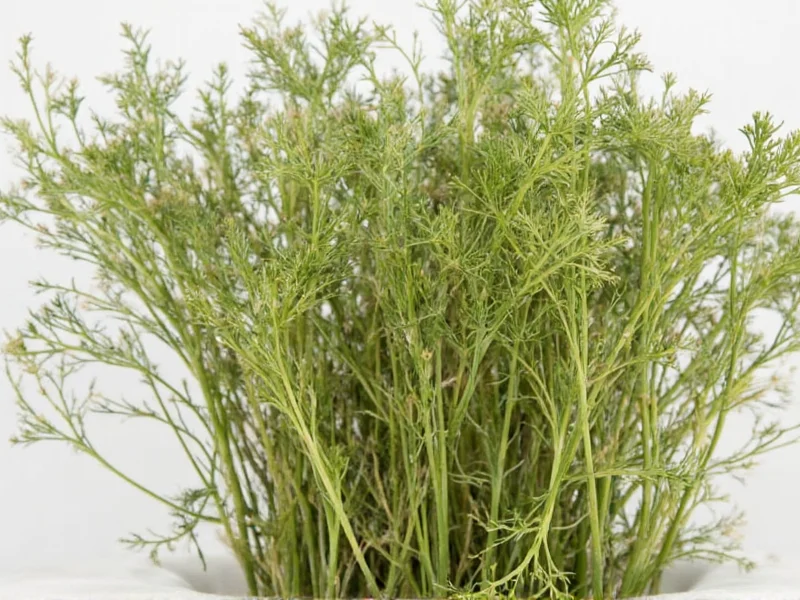Dried dill weed serves as a versatile pantry staple for home cooks and professional chefs alike. Unlike dill seeds, which come from the plant's fruit and have a stronger, more pungent flavor, dill weed refers specifically to the feathery green leaves of the Anethum graveolens plant that have been carefully dried to preserve their distinctive taste.
Understanding Dill: Weed vs. Seed
Many home cooks confuse dill weed with dill seed, but they're distinctly different ingredients with unique flavor profiles and culinary applications. Dill weed encompasses the delicate, fern-like leaves of the dill plant, while dill seeds are the oval-shaped fruits that develop after the plant flowers.
| Characteristic | Dried Dill Weed | Dill Seeds |
|---|---|---|
| Flavor Profile | Grassy, slightly sweet, with citrus notes | Stronger, more pungent, with caraway-like notes |
| Best Culinary Uses | Fish dishes, salads, dressings, dips, soups | Pickling, breads, stews, spice blends |
| Substitution Ratio | 1 tsp dried = 1 tbsp fresh | Not interchangeable with dill weed |
| Storage Duration | 1-2 years for optimal flavor | 3-4 years for optimal flavor |
Flavor Comparison: Dried vs. Fresh Dill
Fresh dill offers a bright, grassy flavor with subtle citrus undertones that works beautifully as a finishing herb. When dried, dill weed undergoes chemical changes that concentrate certain flavor compounds while diminishing others. The drying process intensifies the earthy notes while reducing the delicate freshness, resulting in a more robust but less complex flavor profile.
Understanding dried dill weed substitution ratios is crucial for successful cooking. The standard conversion is 1 teaspoon of dried dill weed equals 1 tablespoon of fresh dill. This 1:3 ratio accounts for the concentration of flavor compounds during the dehydration process. However, when working with older dried dill that may have lost some potency, you might need to adjust slightly upward.
Optimal Culinary Applications for Dried Dill
Dried dill weed shines in recipes where extended cooking time allows its flavors to fully develop. Unlike fresh dill, which can lose its delicate flavor when exposed to heat, dried dill maintains its character throughout the cooking process. Consider using dried dill in:
- Long-simmering soups and stews where fresh herbs would break down
- Marinades that require time for flavors to penetrate
- Dry rubs for meats and fish
- Homemade salad dressings and dips
- Bread and savory pastry recipes
- Casseroles and baked dishes
For best results with dried dill weed in cooking, add it early in the cooking process to allow time for rehydration and flavor development. Unlike fresh dill, which often works best as a finishing touch, dried dill benefits from the opportunity to bloom in warm liquids or oils.
Proper Storage Techniques for Maximum Freshness
The shelf life of dried dill weed depends significantly on storage conditions. Exposure to light, heat, and moisture rapidly degrades both flavor and color. To maximize dried dill weed shelf life:
- Store in an airtight container away from direct light
- Keep in a cool, dark place (not above the stove or near heating elements)
- Avoid storing in the refrigerator where moisture can accumulate
- Use dark glass or opaque containers rather than clear plastic
- Label containers with purchase or drying date
When properly stored, high-quality dried dill maintains optimal flavor for 12-24 months. After this period, while still safe to consume, the herb gradually loses its aromatic compounds and becomes less potent. The best way to test dried dill weed freshness is by aroma—vibrant dried dill should have a distinctly grassy, slightly sweet scent.
Avoiding Common Dried Dill Mistakes
Many home cooks make critical errors when working with dried dill that compromise their dishes. The most frequent mistakes include:
- Using equal amounts of dried and fresh dill (remember the 1:3 ratio)
- Adding dried dill too late in the cooking process
- Storing dried dill in clear containers on spice racks exposed to light
- Keeping dried dill near the stove where heat degrades quality
- Using dill seeds when a recipe calls for dill weed (and vice versa)
Sourcing Quality Dried Dill Weed
When purchasing dried dill weed, look for products with vibrant green color rather than dull brownish-green, which indicates age or poor storage. The leaves should be intact rather than heavily crushed. Reputable spice companies typically provide harvest or packaging dates, which helps assess freshness.
For those interested in dried dill weed recipes, consider incorporating it into potato salad, cucumber salad, fish dishes, or homemade tzatziki. Its concentrated flavor works particularly well in dishes that benefit from extended cooking times where fresh dill would lose its character.
Creating Your Own Dried Dill at Home
Making dried dill at home preserves maximum flavor and ensures you know exactly what's in your herb. The simplest method involves:
- Harvesting fresh dill when morning dew has evaporated but before midday heat
- Washing gently and patting completely dry
- Removing leaves from stems
- Spreading in a single layer on a baking sheet
- Drying in oven at lowest setting (170°F/75°C) for 2-4 hours
- Storing in airtight container once completely cooled
Alternatively, air-drying works well by bundling stems and hanging upside down in a warm, dark, well-ventilated space for 1-2 weeks. The key to successful homemade dried dill is removing all moisture while preserving as much volatile oil as possible.
Nutritional Profile and Potential Benefits
Dried dill weed retains many of the nutritional properties found in fresh dill, though concentrated due to water removal. It contains vitamin A, vitamin C, manganese, and dietary fiber. While not consumed in large enough quantities to serve as a significant nutrient source, dill has traditionally been used for digestive support and as a mild diuretic.











 浙公网安备
33010002000092号
浙公网安备
33010002000092号 浙B2-20120091-4
浙B2-20120091-4